Oregon’s Willamette Valley, where Pinot Noir reigns as king, is only one of two U.S. geographic areas awarded international name recognition and protection by the European Union. (The other is California’s Napa Valley). The Willamette Valley, itself an American Viticultural Area (AVA), the U.S. equivalent of an appellation, has ten AVAs within it. Pinot Noir, a grape famous for expressing terroir, accounts for anywhere from 70 to 85 percent of the plantings in the Willamette, depending on the AVA. Undoubtedly, these AVAs have unique terroirs that have the potential to make distinctive and different Pinot Noir. But can the consumer really recognize the differences? Can a consumer expect that Pinot Noir made from grapes grown in the Yamhill-Carlton AVA will have a different character compared to one from the Dundee Hills?
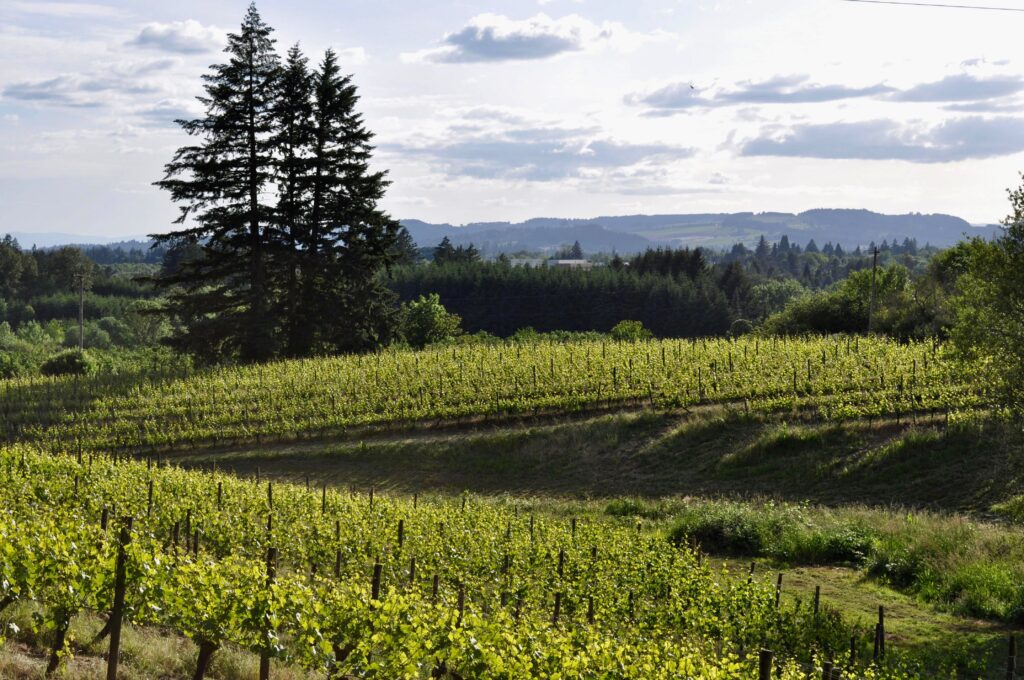
The idea that terroir—the soil, localized climate and customs—determines the character of the wine is difficult for most non-European consumers to understand. Europeans have an extensive system of regulated PDOs (Protected Designation of Origin) and PGIs (Protected Geographical Indication) for agricultural products as well as for wine. In France, there are hundreds of protected names for cheeses. But the concept in fact does extends to other foods, such as prunes, for example. There are pruneaux (prunes) and then there are pruneaux d’Agen, prunes that command a higher price because of their quality and specific area of provenance. In the example given, they come from the area surrounding the small village of Agen in southwestern France, a PGI based on terroir.
The scientist in me says that the only way to begin to understand terroir’s influence on wine is to limit other key elements in determining a wine’s character, such as the producer’s philosophy or style and the vintage. If I’m tasting two wines made from the same grape grown in two different appellations made by two different producers, are the differences in the wines due to the appellation or to the winemaking style? And if the wines are not from the same vintage, then who knows what’s causing the differences between them. The key to appreciating terroir is to keep everything else constant by comparing the same producer’s wines from the same vintage made from grapes grown in different sites.
In Burgundy, considered ground zero for terroir as evidenced by its inclusion in UNESCO’s World Heritage List based on that concept, the major négociants have made the different terroirs there understandable even to the average consumer. Using the same winemaking philosophy and techniques for their wines, each négociant makes wines from villages and vineyards throughout the region. Anyone who descends into the cellars of Maison Louis Jadot or Maison Joseph Drouhin in Beaune and tastes a range of their Burgundies can hear the terroir speaking because the winemaking philosophy is constant. It’s far more difficult to identify terroir in other parts of the world, because most producers outside of Burgundy make wines from only a few different sites or appellations. But surely the concept of terroir exists outside of Burgundy. It’s just harder to identify.
To examine the concept of terroir as it applies to the AVAs within the Willamette Valley, I asked the Willamette Valley Wineries Association to request producers to send me samples of their Pinot Noir from the same vintage made from grapes grown in different AVAs. Producers submitted the same vintage of a Pinot Noir from two (or sometimes three) different AVAs within the Willamette. Tasting these pairs (or triplets) from the same producer would, I thought, highlight the differences among the AVAs—and indeed, it did. The question remains, is there a common thread that identifies the AVA across all producers?
Two major components of terroir, which theoretically should define the AVAs, are soil and climate. Jacques Lardière, Jadot’s legendary winemaker of 40+ years who helped launch Résonance, their Willamette Valley property, summarized the importance of the soil succinctly, “They are words of the ground.”
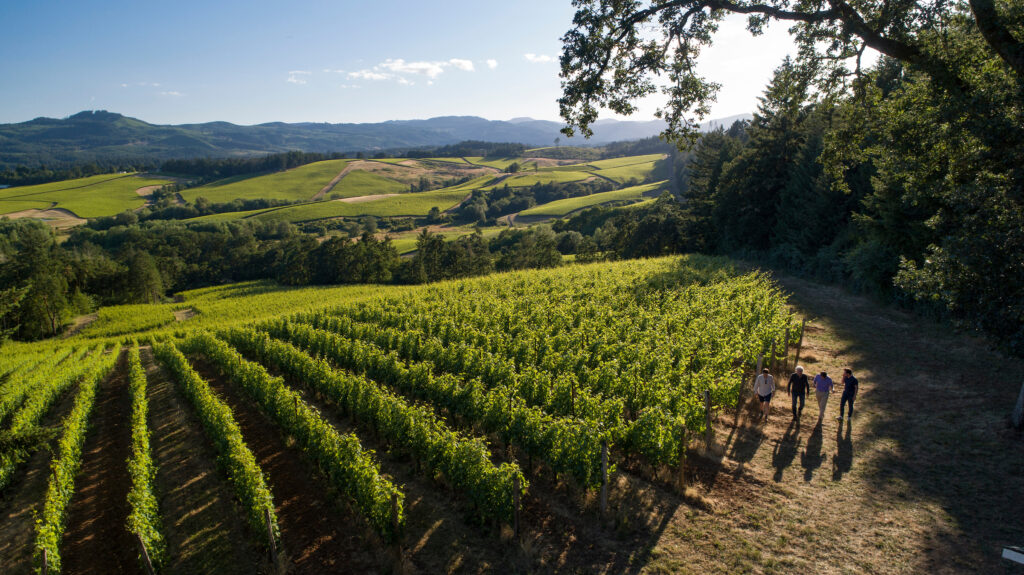
I’m no geologist, but for simplicity, the origin of the wide variety of soils in the Willamette came from four over-riding geologic events. Thirty-five million years ago, this part of Oregon was under the ocean floor, which explains the marine sediments that are found, to a greater or lesser extent, throughout the AVAs of the Willamette. Ancient volcanic eruptions explain the basalt soils while millennia of prevailing winds caused erosion and have blown silt (loess) across the region. And, finally, The Missoula Floods and glacial residues from the last ice age left their mark on the valley.
Climate and temperature vary between, and even within, AVAs, depending on the elevation of the vineyards, the surrounding hills as well as the passes through the mountains, such as the Van Duzer Corridor. These topographic variables account for different wind and rain patterns that affect the grapes in a multiple of ways from disease burden to date of harvest.
For this tasting, I had sufficient comparable samples to focus on five of the Willamette’s ten AVAs: Dundee Hill, Yamhill-Carlton, McMinnville, Eola-Amity Hills and Chehalem Mountains. (For completeness, the other five AVAs are Ribbon Ridge, Van Duzer Corridor, Tualatin Hills, Laurelwood District, and Lower Long Tom). So, what are the defining geologic characteristics of those five AVAs and how do the wines compare?
The Dundee Hills AVA, where David Lett planted Oregon’s first Pinot Noir at his Eyrie Vineyards, was created in 2005. Its 890 planted hectares are on basalt soil overlying sedimentary sandstone. The Coastal Range mountains protect it from maritime influences, shielding the area from rain. The AVA’s lower base is a 200-foot contour line which marks the level of sediment left by the Missoula Floods.
Eola-Amity Hills, established in 2006 and now with about 1,214 planted hectares, is a cooler AVA, located as it is, in the Van Duzer corridor, a gap in the coastal range of hills that gives direct contact with the Pacific Ocean. The result is slower and later ripening grapes. Some growers attribute black rather than red fruit flavors, firmer tannins, and more structure of its wines to the shallow basalt (volcanic) soil. Guillaume Large, the winemaker at Résonance and now makes Pinot Noir from that AVA, describes them as fruity, “with red and black fruits, floral notes, density, roundness and depth.”
Véronique Drouhin has long been the resident winemaker at Domaine Drouhin Oregon, which her family established in the Dundee Hills in 1987. With vineyards there as well as in the Eola-Amity Hills, she has extensive experience with both these AVAs. In addition to the differences in soil and climate, she notes that the hillsides are steeper in Dundee Hills. She describes their Pinot Noir from Dundee Hills as softer and rounder compared to more structured ones from Eola-Amity Hills. Using a rough analogy with Burgundy, she believes it’s reasonable to compare the differences between the Pinot Noir from Dundee Hills and those from Eola-Amity Hills to the wines from Chambolle-Musigny and Gevrey-Chambertin, respectively.
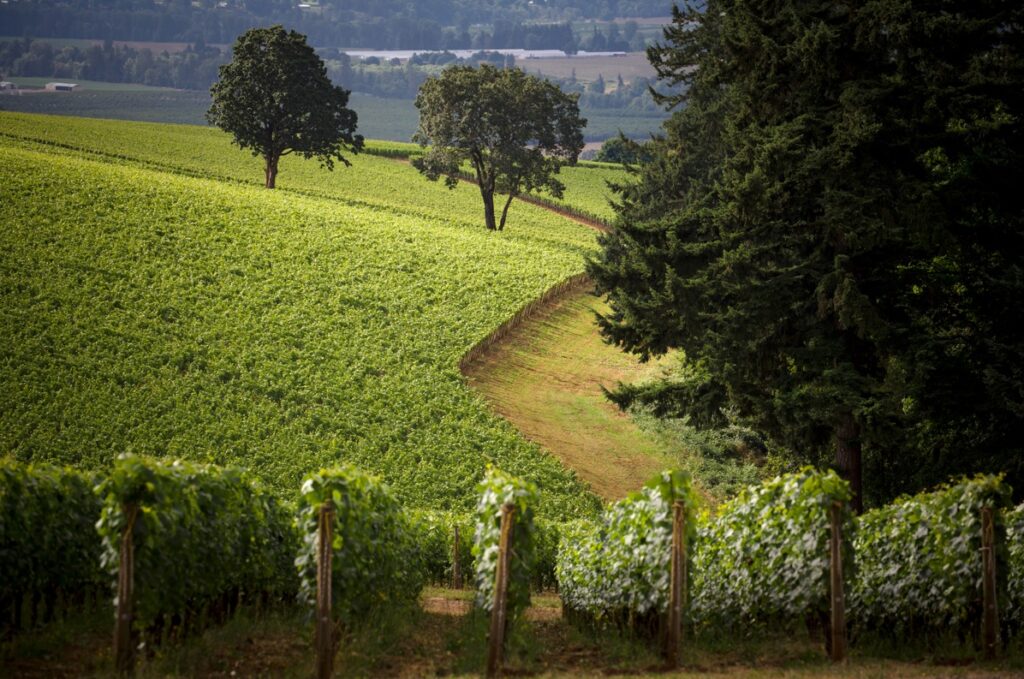
The Yamhill-Carlton AVA, established in 2004 and containing about 1,052 planted hectares, is a valley surrounding the two towns from which the AVA is named. Marine sedimentary soil mixed with the usual volcanic bedrock is common in this warmer area. Large explains that the Coastal Range Mountains put the AVA into a “rain shadow” that protects the area from the wind and dampness of the Pacific Ocean. This warmer climate predictably leads to richer wines with softer tannins, according to producers.
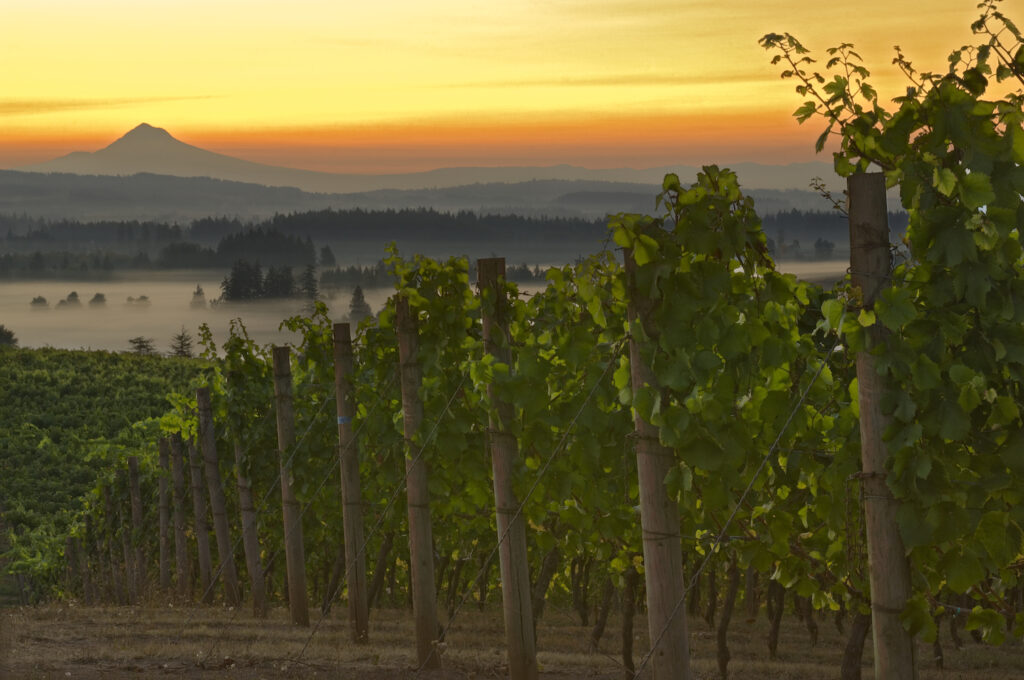
The Chehalem Mountains AVA, established in 2006, is, as the name suggests, at a higher elevation and thus, a cooler area. Its 1,093 hectares are planted on all three soil types, loess, sedimentary and volcanic.
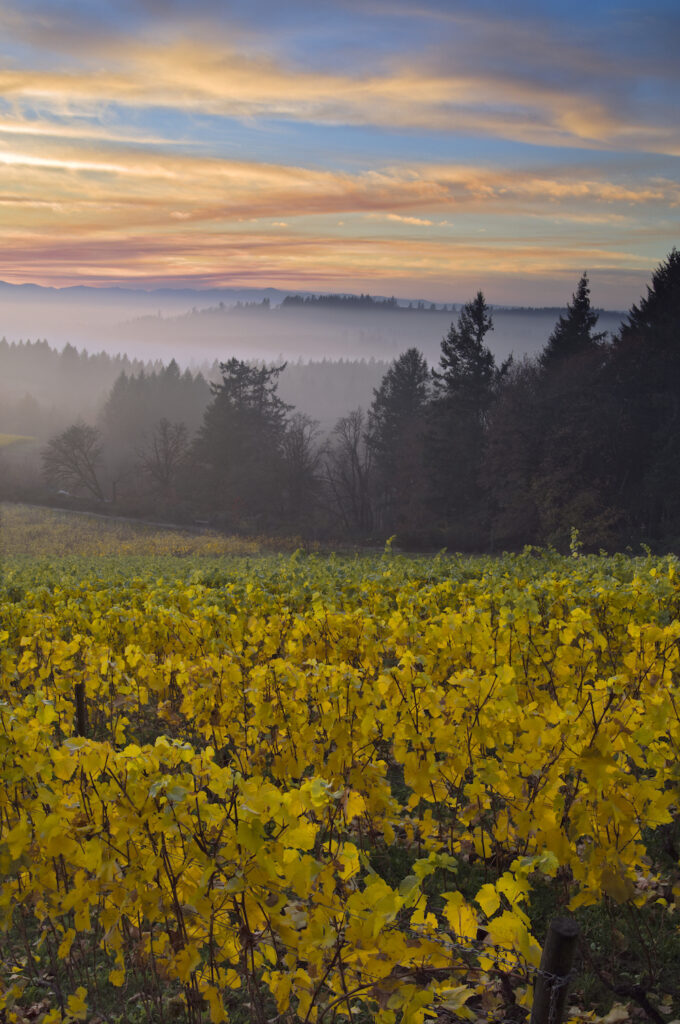
Similarly, the McMinnville AVA, established in 2005, rests at a cooler, higher elevation and receives drying winds from the Van Duzer corridor. The Coastal Range protects its 648 planted hectares, which sit on shallow loamy soil atop a basaltic base.
As this simplified summary of the different soils and climate of the AVAs shows, there is considerable overlap from one AVA to another. Since the individual AVAs contain multiple types of soils and the climate is not uniform within an AVA, variability among the wines from an individual AVA, especially when factoring in the producers’ proclivities, is understandable.

Though the range of styles of the wines from the Dundee Hills is vast, a common red-fruited thread and softer structure shows clearly. Both the mid-weight 2018 Résonance Découverte Vineyard and the more muscular Nicolas-Jay Nysa Vineyard bottling, despite their differing weights, convey lovely red fruit and savory notes accompanied by fine tannins. Similarly, the thread of bright red fruit flavors and suave texture of Domaine Drouhin Oregon’s 2018 Laurène bottling ties it tightly to the Dundee Hills. From the same vintage, the more robust Roco Winery’s Knudson Vineyard still displays cherry-like notes with silky tannins for which the AVA is known. Both the finesse-filled 2018 Lange Estate Vineyard and the mid-weight 2018 Argyle Spirithouse bottling, with their ripe sweet red cherries, highlights that element common to the Dundee Hills.
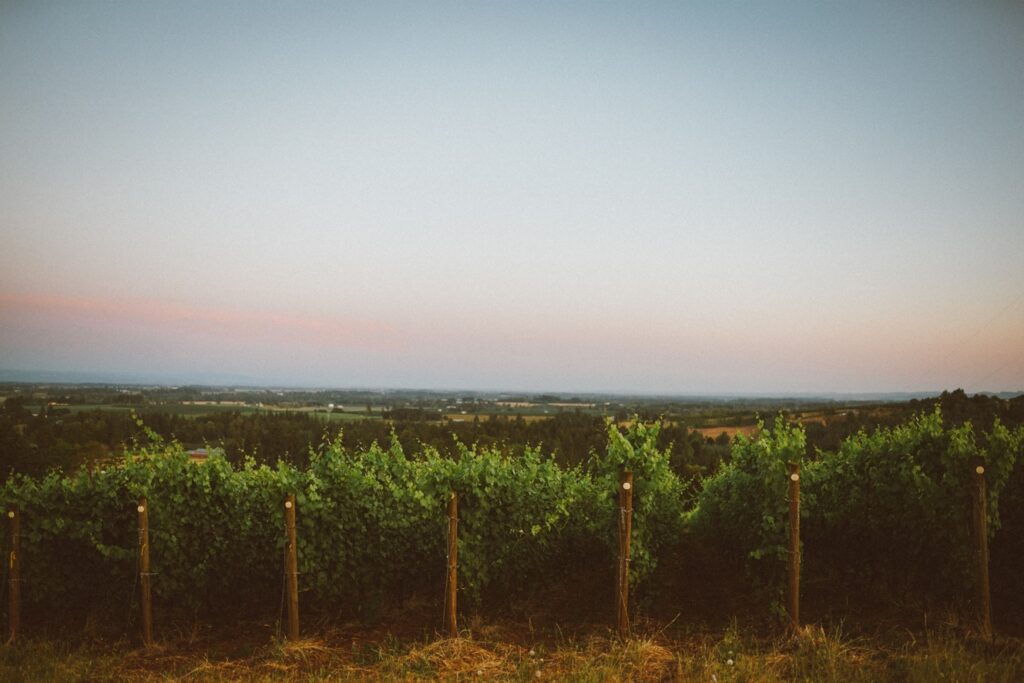
The weightier and dark-fruited 2019 Domaine Roy & Fils Iron Filbert Vineyard could make one wonder if it came from the Dundee Hills. The softer tannins do suggest its origins, but the black fruit suggests another AVA. The beautifully bolder and more minerally character of their Quartz Acorn Vineyard Yamhill-Carlton bottling shows that the relative differences between the AVA holds up, accounting for the producer’s style.
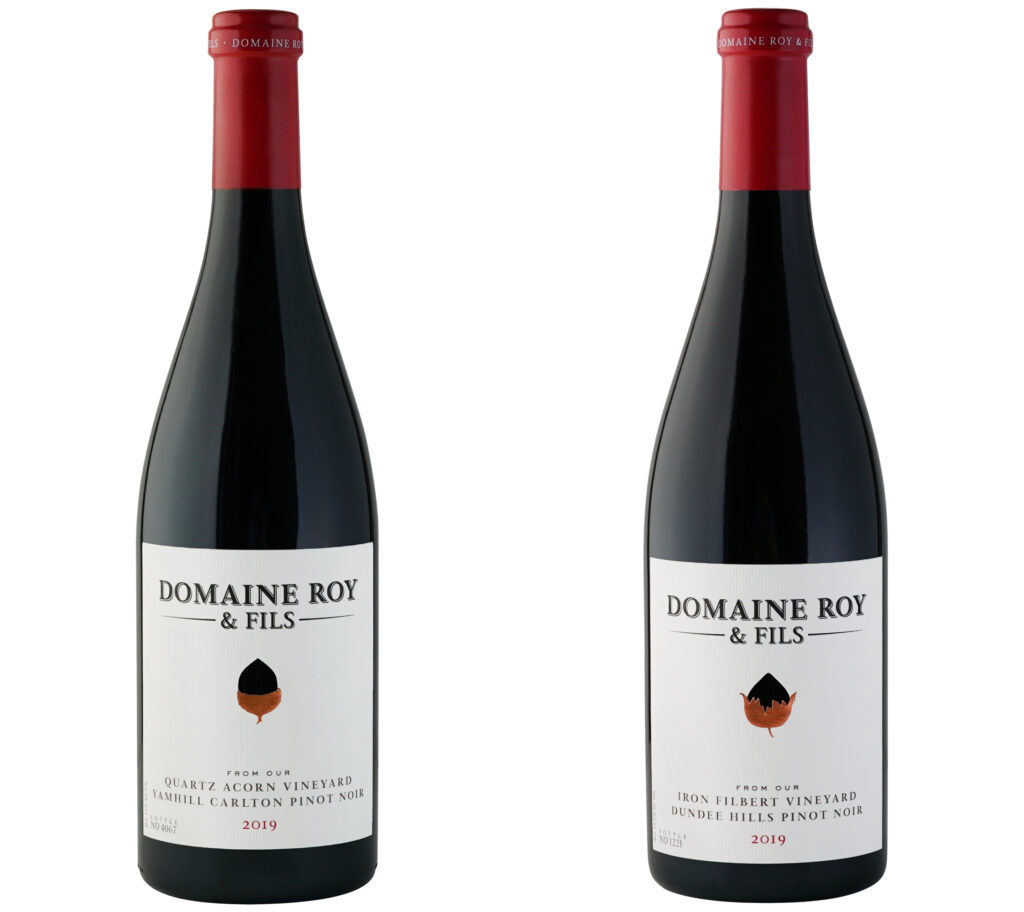
The captivating mature flavors of the 2014 Matzinger Davies Dundee Hills bottling shows that the borders of the AVAs can become blurred with age. That said, the bright and lively character of wines from the Dundee Hills is still evident, especially when compared to their equally enjoyable more robust and structured 2014 from the Eola-Amity Hills.
Similar to the wines from the Dundee Hills, the wines from Yamhill-Carlton have a common identity—additional power that distinguishes them from the more elegantly framed wines of Dundee Hills. And although the wines from Eola-Amity Hills are also more robust than those from Dunhill Hills, their overall character is different from Yamhill-Carlton, displaying more in the way of black fruitiness and less dark minerality. Despite their weightier character, none of the wines from either Yamhill-Carlton nor Eola-Amity Hills are heavy. There are no over-ripe wines that would put them into the Pinot-Syrah category, so when I refer to them as more powerful or muscular, it is in relative terms, especially compared to Dundee Hills Pinot Noir. There is less variation and a clearer sense of the AVA in wines from the Yamhill-Charlton AVA compared to those from the Dundee Hills, at least from the array I tasted.
With its dark fruit and minerals, the elegant 2018 Résonance Vineyard bottling (Yamhill-Carlton) contrasts beautifully with their lighter and more sprightly Dundee Hills Pinot Noir. Similarly, the graceful Nicolas-Jay Bishop Creek Vineyard (Yamhill-Carlton) is clearly bolder and more structured than their Dundee Hills Nysa Vineyard bottling. Even with their overall bolder style, the difference in weight between the black-fruited Roco Winery’s 2018 Marsh Estate Vineyard (Yamhill-Carlton) and their lighter, but still powerful, Knudson Vineyard (Dundee Hills) offering is clear. Despite a little age, the robust character of Yamhill-Carlton’s wines is apparent judging from the 2016 Boedecker Cellars Hirschy Vineyard, which conveys power without going overboard. Similarly, the elegant and powerful 2016 St. Innocent Shea Vineyard (Yamhill-Carlton) bottling shows how beautifully these wines develop.

The graceful wines from Penner-Ash put the differences between Yamhill-Carlton and Eola-Amity Hills into clear relief. Their splendid 2018 Estate Vineyard (Yamhill-Carlton) displays more structure and dense minerality compared to their equally beguiling 2018 Zena Crown Vineyard (Eola-Amity Hills) whose dark fruitiness moderates its gorgeous minerally character.
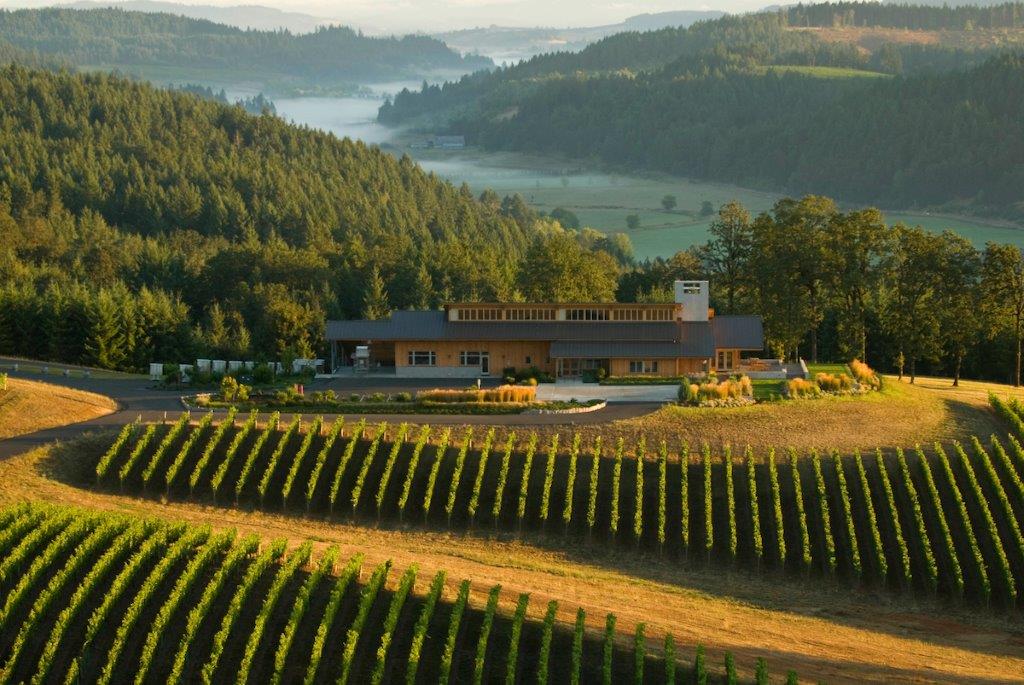
Domaine Drouhin Oregon’s dazzling 2018 Roserock “Zéphirine” (Eola-Amity Hills) displays dark cherry-like fruit along with a subtle minerality supported by firm, not hard, tannins emblematic of the Eola-Amity Hills. Even accounting for the lacey Drouhin style, wines from Eola-Amity Hills seem to have less oomph than those from Yamhill-Carlton. The agile Argyle 2018 Nuthouse bottling (Eola-Amity Hills) also displays weightier black cherry-like notes, without showing the density or mineral-infused aspect of Yamhill-Carlton. The stylish Pinot Noir from Dobbes Family Estate (Eola-Amity Hills) meanwhile combines savory and fruity notes with the underlying structure typical of the AVA. At seven years of age, the elegant 2014 Matzinger Davies (Eola-Amity Hills) displays the power associated with the wines from that AVA, especially compared to theirs from the Dundee Hills.
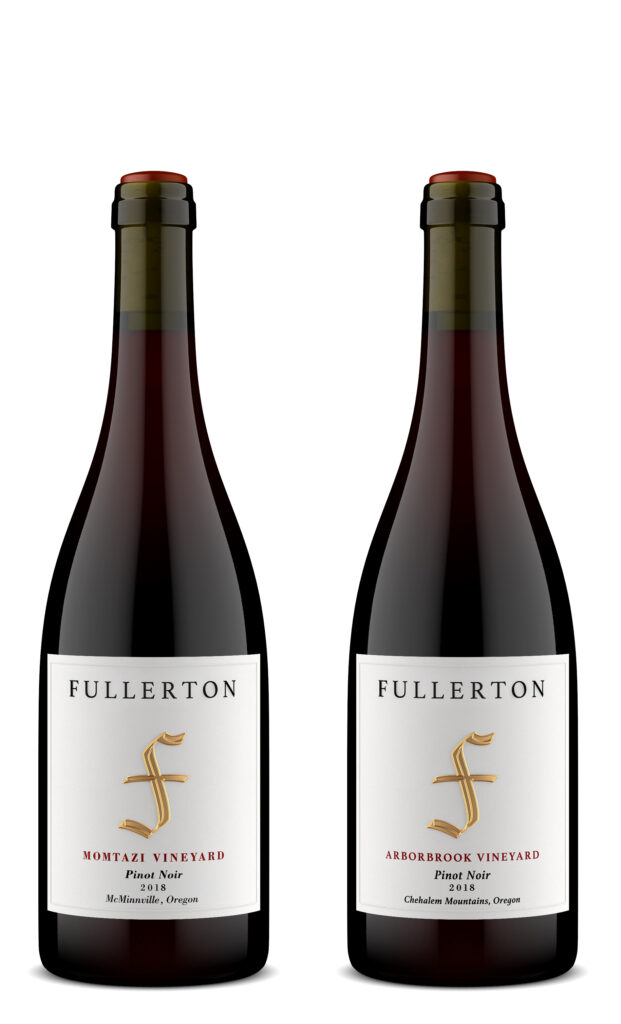
I found the stylistic range of Pinot Noir from the McMinnville AVA even greater than that from the Dundee Hills AVA. The 2018 Dobbes Family Estate (McMinnville) emphasized an opulence, for example, especially compared to the stunning tension-filled 2018 Nicolas-Jay Momtazi Vineyard (McMinnville). The 2018 Fullerton Momtazi Vineyard displayed floral elements in addition to the appealing chiseled angularity of the Nicolas-Jay. Even with a couple additional years of age, the 2016 St. Innocent from the same vineyard displays the same engaging firmness, which in this case, balances the wine’s creamy maturity. In contrast, the charming ballerina-like 2018 Raptor Ridge Meredith Mitchell Vineyard (McMinnville’s) emphasizes grace and delicacy along with a flowery character. All these wines are lighter and tauter than the ones from Yamhill-Carlton or Eola-Amity Hills.


Pinot Noir from the Chehalem Mountains project the attractive austerity and angularity expected from vineyards located at higher and cooler elevations. Despite the various soil types and winemaking philosophy, a common thread of firmness and minerality is apparent. The 2018 Raptor Ridge Tuscowallame Estate 777 highlights red fruit flavors atop a sharply carved frame. Similarly, Fullerton’s 2018 Arborbrook Vineyard displays firm tannins supporting its fleshy features. In the same vein, the 2018 Roco Winery Wits End Vineyard Private Stash No. 16 is minerally, lean and taut. Likewise, the muscular 2018 Chehalem Wines Coral Creek Vineyard delivers a captivating stony quality. Granitic firmness is equally apparent in the bold and balanced black-fruited 2017 J. Wright Vintner Chehalem Mountains bottling. Even with a little bottle age, the 2016 Boedecker Cellars Finnigan Hill Vineyard still displays a sculpted scaffolding along with its compelling black cherry fruitiness.
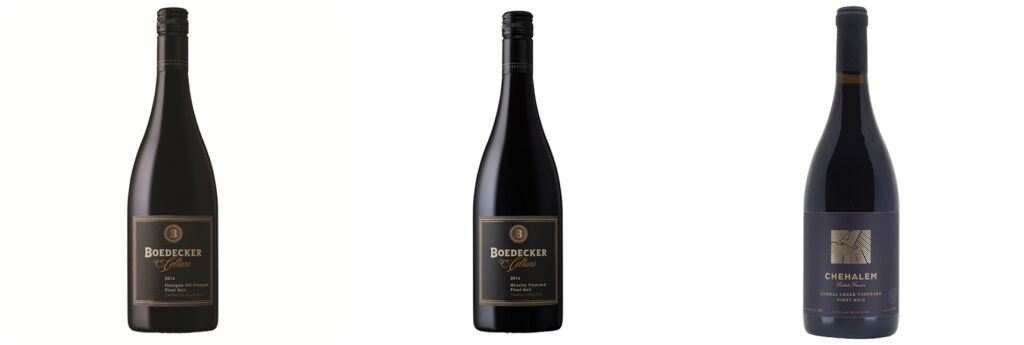
I draw several important conclusions from this tasting. The consistency of these Willamette Pinot Noirs is staggering. After my tastings, I distributed the samples to two top sommeliers in the Boston area. Both reported how impressed they were with the overall quality of the wines. Clearly, a plethora of talented producers exist in these AVAs. Importantly, though there are clear differences among the AVAs, there is an overall consistent style of Pinot Noir coming out of the Willamette. None of these wines were heavy or, worse yet, venturing into the Pinot Syrah category that can afflict Pinot Noir made from grapes grown on warmer sites or from winemakers who value power over elegance.
Certainly, for any individual producer, the AVAs speak loudly and clearly. The distinctiveness and uniqueness of the AVAs holds up within a producer’s line-up. The differences between Resonance’s black-fruit, minerally Yamhill-Carlton Pinot Noir differs clearly from their red-fruited and spicy one from the Dundee Hills. And those differences held up across both the 2018 and 2017 vintages. In a like manner, Domaine Drouhin Oregon’s bright and pure red-fruited Dunhill Hills Pinot Noir is strikingly different when tasted next to their dark-fruited and more structured Pinot Noir from Eola-Amity. Similar differences were obvious among all of the pairs and triplets that I tasted. Clearly, terroir is alive and present in the Willamette.
If I had to describe the AVAs succinctly, the Dundee Hills would be red cherry-fruited, Yamhill-Carlton black cherry-fruited, Eola-Amity Hills minerally, Chehalem Mountains firm and stony, and McMinnville chiseled.
However, once you taste a series of wines from, say, the Dundee Hills made by different producers, the character of the AVA is not so clearly defined. Did the bolder black-fruited 2018 Nicolas-Jay Nysa Vineyard and the more red-fruited and lacier 2018 Lange Estate Vineyard really come from the same AVA? The question, of course, is it producer style or is it the variation of soil and climate even within the Dundee Hills that accounts for the differences between the wines from the same AVA. I suspect it’s a bit of both.

In reality, the situation in the Willamette is no different from that in Burgundy’s Côte d’Or. The AVAs or appellations are clearly different one from the other. But the producer plays a critical role. Just as two wines from Bonnes Mares will differ depending on the producer, so will wines from the same Willamette vineyard, as the three wines from McMinnville’s Momtazi Vineyard show. So, when buying Willamette Pinot Noir, or Burgundy for that matter, consider the AVA, but remember it’s still producer, producer, producer.
Acknowledgements:
I am grateful to the Willamette Valley Wineries Association, which kindly offered to arrange for its members to send me samples. I am also grateful to those producers and others who sent me samples.

 中文
中文




[…] [ click to read in a new tab ] […]
Thanks for the superb article and magnificent photographs of the most beautiful wine producing areas in America. Yes average quality for single vineyard Oregon Pinots in all the AVAs has reached a peak that would not have been possible 15 or 20 years ago. For those of us priced out of 1er and Grand Cru Burgundies, the best Oregon Pinots while no longer bargains, are still within reason.